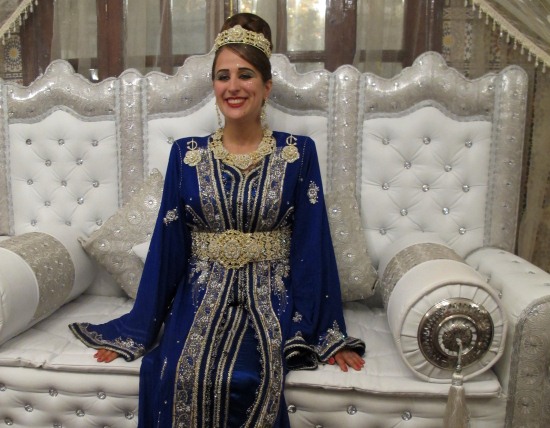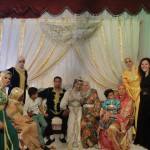Everything You Need To Know About Moroccan Weddings

Moroccans tend to invite everyone to join in their families’ and friends’ nuptial bliss, and enjoy Moroccan weddings. Hospitality is a lovely and inclusive aspect of Moroccan culture, so even if you are visiting for only a week or a month, it is always possible that you will end up at your new best friend’s cousin’s sister’s neighbor’s wedding.
The first time I was invited to a Moroccan wedding, I found myself ordering a single cone of sugar from the local corner store. “They’re going to be so impressed that I knew what type of traditional gift to bring!” I thought to myself proudly. Next to Arabic mastery, the finer points of Moroccan culture are considered essential integration tools for Peace Corps volunteers like me. Sugar cones are the clutch gift for any Moroccan celebration—and like a sort of gift card—a classy and indirect way of handing the happy couple some cash.
Families will both use the sugar (if you’ve ever tasted the extreme sweetness of Moroccan mint tea, you’ll understand where the larger portion of a cone will end up) and return the cones to local stores in exchange for money. Brimming with this much knowledge, anyone can see why a single sugar cone would make me so confident.
As fate would have it, however, I slightly miscalculated my mastery of Moroccan culture.
As fate would have it, however, I slightly miscalculated my mastery of Moroccan culture. Including my gift: cones of sugar are meant to be given in mass-quantity. Think Costco as opposed to dollar store. Despite this misfire, my single, miskin (loose translation: “pathetic”) sugar cone was accepted with a smile. I could see the subtitles beneath my hosts’ empathetic eyes: “Maybe in America people only give one sugar cone at weddings. Strange, but we’ll take it!”
If you, too, have received your first invitation to a traditional Moroccan wedding, you probably desire more guidance than just tips for selecting sugar cones. What to do next? Well, you can learn from my mistakes. And possibly make some new colorful faux-pas of your own! Here’s what to expect:
Everything You Need To Know About Moroccan Weddings
Clothing
The majority of other women at Moroccan weddings will be outfitted in the traditional takshita. This is a garment that has two layers—the base is typically a long, Hogwarts uniform-esque sheath with a high neck, long sleeves, and a floor-length skirt. The second layer is worn over the first and tends to be from a more loose and translucent fabric. Both pieces are anchored on the body with a massive, bejeweled belt placed on the waist.
If you don’t happen to have one in your closet, don’t worry—I have never attended a wedding where the women come unprepared. Fellow wedding-goers will often invite you to try on the spare takshitas they have brought. Be forewarned, though—women rarely come to weddings wearing their takshitas but rather bring everything in a bag and get dressed together. I recommend following suit. This is female bonding at its finest!
Singing and Dancing
Feigning exhaustion or disinterest will not grant you a “Get out of Dancing Free” card. Like many of my Western counterparts, I am incapable of moving my hips like Moroccan women—and the sight of a cameraman recording every moment of the wedding might induce above-average levels of performance anxiety. Rest assured that any dancing effort on your part will be rewarded with encouragement and, at the very least, amusement for your fellow wedding-goers. My secret to participation with minimal embarrassment? Join the circles of kids flailing their arms around. No one can make fun of you too much if you’re keeping their children entertained with the exaggerated moves of a disco queen.
Performers at weddings can range from DJs to drum circles. All musicians will expect to be tipped and will pursue you until this happens. Avoid misunderstandings—come with several 20 dirham bills that you don’t mind donating.
The Ceremony
The bride will make her entrance surrounded by an entourage. Unlike our idea of bridesmaids, these women, nageffet, are paid to attend to the bride (brilliant idea?). They supply the bride’s dresses, accessories, and assist her with her poses for the camera. The first (yes, first) dress is traditionally green and gold. And the bride begins by wearing this outfit to receive henna on her hands and feet. Afterwards, there are usually five costume changes, with each dress representing a different region of Morocco.
At some point, the groom will join in the festivities. He usually makes a grand entrance. Sometimes on horseback, other times in a car with his family. In fact, he’ll be bearing gifts for his new bride. He will sit next to the bride, pose for pictures, and even participate in several costume changes himself. Some couples opt for a ride in the ameriya. This is a platform held up by four wedding attendants. The bride and groom take separate rides. Often waving their arms and smiling at the audience. Feel free to take pictures and even pose with the bride and the groom. Of course, beware of posting them online without explicit permission.
Two meals will be served upon the conclusion of the wedding. Chicken, and beef with prunes. Both will be in communal-style dishes that you will eat with your hands. Don’t be shy! Afterwards, guests will unceremoniously begin to head home. Follow suit (but give back your takshita to its rightful owner first!) and pat yourself on the back. You’ve done it, girl!
A relevant side note: my knowledge of Moroccan weddings has been gathered not only through extensive field research, but also by sitting through my own! Photographic evidence is included.
About Sarah Quinn
Sarah Quinn graduated from the University of Georgia in 2011 with a BA in Art History and a BFA in Painting. In September of that year, she began her Moroccan journey as a Youth Development Peace Corps volunteer in Tameslouht, Morocco. Her time in this lovely country has been devoted to working with women artisans. Including developing art education in rural areas, and learning more about the traditional and contemporary arts of the area. Read more by visiting her blog where she records the strange, hilarious, and beautiful happenings of her ever-comical life here in Morocco: http://quinninmorocco.wordpress.com.









LOL very funny reading this, sounds like you enjoyed it. But your experience is not the typical Moroccan wedding. I am Moroccan, I should know 😛
What you experienced is probably customs of one neighborhood, there are variations, and the majority of weddings in Morocco start late and finish at sunrise. There is also a separate night called the Henna night which is a day before the Walima. And most weddings will last 3-7 days. With lots of feasts and pampering of the bride, as happened with myself my wedding lasted 3 days, Thank God/Alhamdulillah.
Also many Moroccans practice Islam so we have segregated with weddings with NO music, only a female Nasheed group with the simple Duff as per religious obligation. And deffo not male photographers etc. What you experienced was only one example of a Moroccan wedding.
And the Food is never the same region to region. The Groom brings a Sheep, or two or more, as a gift and it is slaughtered on the day of the wedding and cooked for the evening meal for the guest per Islamic wedding.
The way you explained the wedding almost sounds Jewish, as there is a large population of Jews in Morocco they also have similar traditions and it almost sounds like you attended a Jewish wedding and not a Traditional Moroccan Muslim Wedding.